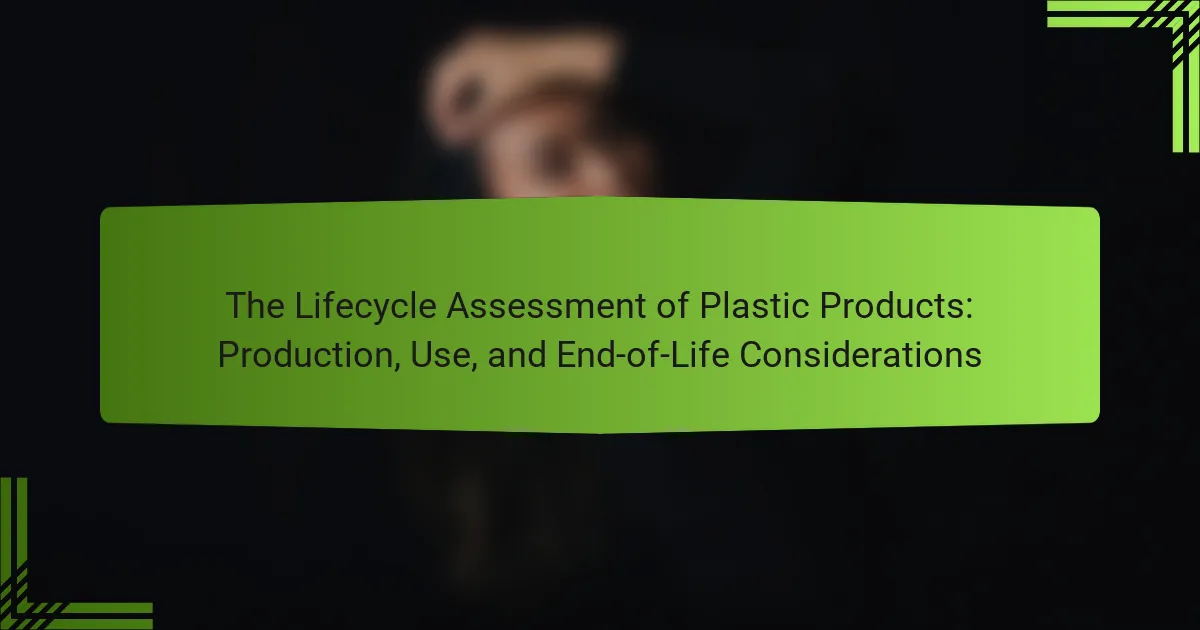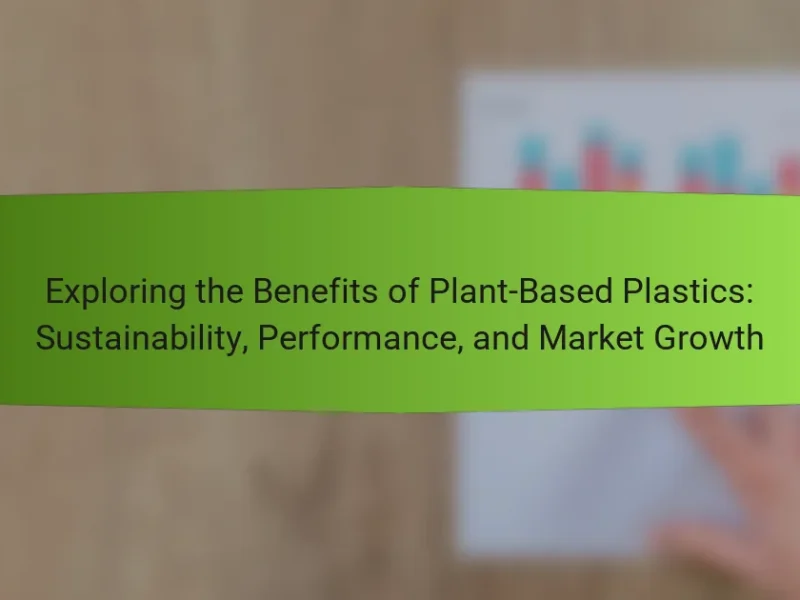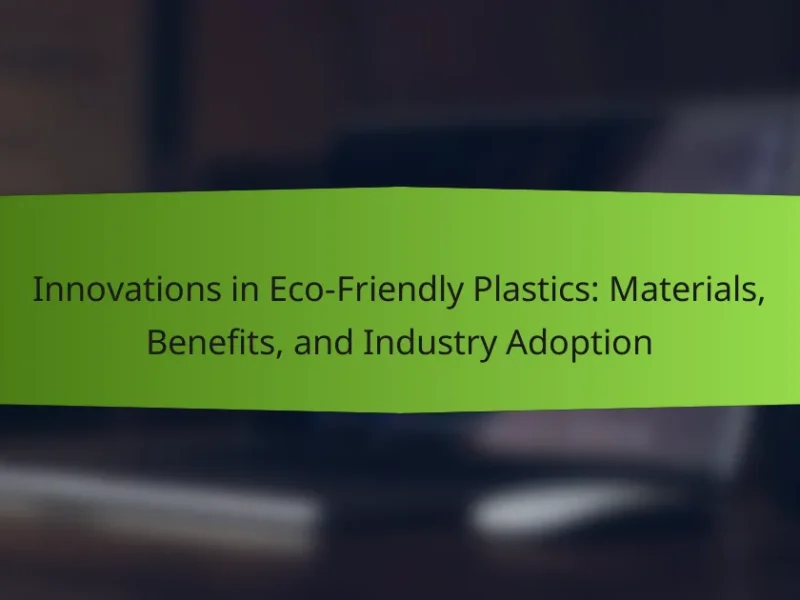The Lifecycle Assessment (LCA) of plastic products is a systematic approach that evaluates the environmental impacts throughout the entire life of plastic items, encompassing raw material extraction, production, distribution, use, and end-of-life disposal or recycling. This assessment focuses on key factors such as greenhouse gas emissions, energy consumption, and resource depletion, following standardized frameworks like ISO 14040 and ISO 14044 to ensure reliability. The production phase significantly influences the overall environmental footprint, while the use phase contributes to energy consumption and emissions. Improving LCA methodologies through enhanced data accuracy and stakeholder engagement can lead to more sustainable designs and practices in plastic product development.
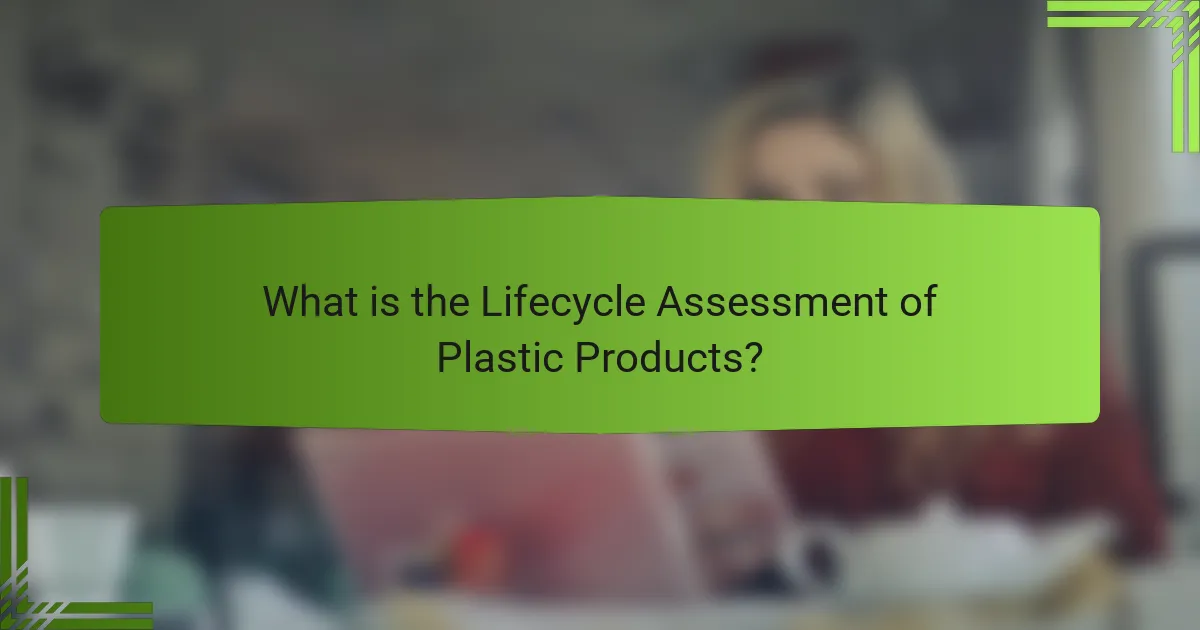
What is the Lifecycle Assessment of Plastic Products?
The Lifecycle Assessment (LCA) of plastic products is a systematic analysis of the environmental impacts associated with all stages of a plastic product’s life. This includes raw material extraction, production, distribution, use, and end-of-life disposal or recycling. LCA evaluates effects such as greenhouse gas emissions, energy consumption, and resource depletion. It provides a comprehensive view of the sustainability of plastic products. The methodology follows standardized frameworks like ISO 14040 and ISO 14044. These standards ensure consistency and reliability in LCA results. By assessing the entire lifecycle, stakeholders can identify opportunities for improvement and make informed decisions.
Why is Lifecycle Assessment important for plastic products?
Lifecycle Assessment (LCA) is important for plastic products because it evaluates their environmental impacts throughout their entire lifecycle. This includes production, usage, and end-of-life stages. LCA helps identify areas for improvement in sustainability. It provides data on resource consumption, emissions, and waste generation. By analyzing these factors, manufacturers can make informed decisions to reduce negative environmental effects. Furthermore, LCA supports compliance with regulations and consumer demands for eco-friendly products. Studies indicate that LCA can lead to a 30% reduction in carbon footprint when improvements are implemented. Overall, LCA is a critical tool for promoting sustainability in the plastic industry.
What are the key stages in the lifecycle of plastic products?
The key stages in the lifecycle of plastic products are production, distribution, use, and end-of-life management. Production involves the extraction of raw materials, such as petroleum, and the manufacturing of plastic items. Distribution includes transportation to retailers and consumers. Use refers to the period when consumers utilize the plastic products. End-of-life management encompasses disposal methods, including recycling, incineration, and landfilling. According to the Ellen MacArthur Foundation, approximately 79% of plastic waste ends up in landfills or the environment, highlighting the importance of effective end-of-life strategies.
How does Lifecycle Assessment impact environmental sustainability?
Lifecycle Assessment (LCA) evaluates the environmental impacts of a product throughout its entire life cycle. LCA identifies areas where improvements can reduce resource consumption and emissions. By analyzing production, use, and end-of-life stages, LCA helps companies make informed decisions. This leads to more sustainable practices and products. For example, LCA can reveal that changing materials or processes reduces carbon footprints significantly. Research shows that LCA can guide policy-making and corporate strategies towards sustainability goals. Overall, LCA is a critical tool in promoting environmental sustainability by providing data-driven insights.
What are the primary phases of plastic product lifecycle assessment?
The primary phases of plastic product lifecycle assessment are raw material extraction, production, use, and end-of-life. Raw material extraction involves sourcing the necessary materials for plastic production. Production refers to the manufacturing processes that convert raw materials into finished plastic products. The use phase encompasses the period during which the product is utilized by consumers. End-of-life includes disposal, recycling, or incineration of the plastic product after its useful life. Each phase contributes to the overall environmental impact of plastic products.
What occurs during the production phase of plastic products?
During the production phase of plastic products, raw materials are transformed into finished goods. This process typically begins with the extraction of petroleum, which is the primary source of most plastics. The extracted petroleum undergoes refining to produce monomers, the building blocks of plastics. These monomers are chemically bonded to form polymers through a process called polymerization.
Once polymers are created, they are melted and shaped into desired forms using techniques such as extrusion, injection molding, or blow molding. Each method allows for the production of various plastic items, from containers to automotive parts. Quality control measures are implemented throughout the production to ensure that the products meet safety and performance standards.
According to the Plastics Industry Association, over 300 million tons of plastic are produced globally each year, showcasing the scale of production activities.
How are plastic products utilized in various industries?
Plastic products are utilized in various industries for their versatility and cost-effectiveness. In the automotive industry, plastics are used for lightweight components, improving fuel efficiency. The packaging sector employs plastics for their durability and ability to preserve food. In healthcare, plastic products are essential for medical devices and packaging due to their sterility and safety. The construction industry uses plastics for insulation, piping, and roofing materials, enhancing energy efficiency. Electronics benefit from plastics in casings and components, providing protection and reducing weight. The consumer goods sector relies on plastics for a wide range of products, from household items to toys, due to their moldability and affordability. According to the American Chemistry Council, plastics contribute significantly to the economy, with over 1.3 million jobs supported in the U.S. alone.
What are the end-of-life considerations for plastic products?
End-of-life considerations for plastic products include recycling, incineration, and landfill disposal. Recycling reduces the need for new raw materials and conserves energy. Incineration can generate energy but releases pollutants. Landfill disposal is the least favorable option, contributing to environmental degradation. The recycling rate for plastics is approximately 9% globally. Proper disposal methods are essential to minimize environmental impact. Consumer awareness and participation in recycling programs can enhance plastic waste management. Effective policies and regulations also play a critical role in improving end-of-life outcomes for plastic products.

How does the production phase affect the lifecycle of plastic products?
The production phase significantly impacts the lifecycle of plastic products by determining their environmental footprint. During production, raw materials are extracted and processed, which consumes energy and resources. For instance, producing one kilogram of plastic typically requires around 2-3 kilograms of fossil fuels. This phase also generates greenhouse gas emissions, contributing to climate change.
The choice of production methods influences the recyclability and durability of plastic products. Advanced manufacturing techniques can enhance product longevity, reducing waste. Additionally, the production phase sets the stage for potential contamination, affecting future recycling efforts. Studies show that over 90% of plastic waste originates from production and consumption processes. Thus, the production phase is crucial in shaping the overall sustainability and environmental impact of plastic products throughout their lifecycle.
What resources are required for producing plastic products?
Plastic products require several key resources for their production. The primary resource is crude oil, which serves as the base material for most plastics. Natural gas is also utilized, particularly in the production of specific types of plastics like polyethylene. Additionally, various additives are necessary; these include stabilizers, colorants, and plasticizers that enhance performance and appearance. Energy is a crucial resource, as significant electricity and thermal energy are needed during the manufacturing processes. Water is also required, primarily for cooling and cleaning purposes. The production of plastic products often involves specialized machinery and equipment, which are essential for processing raw materials. Each of these resources plays a vital role in the overall production of plastic products.
How does energy consumption during production influence overall impact?
Energy consumption during production significantly influences the overall environmental impact of plastic products. High energy usage often correlates with increased greenhouse gas emissions. For instance, the production of polyethylene terephthalate (PET) requires approximately 3.2 MJ/kg of energy. This energy demand contributes to the carbon footprint of plastic manufacturing. Additionally, the source of energy affects the impact; fossil fuels lead to higher emissions compared to renewable energy sources. Studies show that optimizing energy efficiency can reduce emissions by up to 30%. Therefore, minimizing energy consumption during production is crucial for lowering the overall environmental impact of plastic products.
What role do raw materials play in the environmental footprint?
Raw materials significantly impact the environmental footprint of products. The extraction and processing of raw materials often involve high energy consumption. This energy use contributes to greenhouse gas emissions. For example, producing plastic from petroleum-based raw materials releases significant carbon dioxide. Additionally, raw material sourcing can lead to habitat destruction and biodiversity loss. The transportation of these materials also adds to the overall carbon footprint. Studies indicate that raw material production can account for over 70% of a product’s total environmental impact. Therefore, selecting sustainable raw materials is crucial for reducing the environmental footprint.
What are the emissions and waste generated during production?
The emissions and waste generated during the production of plastic products include greenhouse gases, volatile organic compounds, and solid waste. Greenhouse gas emissions arise from the extraction and processing of fossil fuels used in plastic production. For example, the production of one kilogram of polyethylene can emit approximately 2.5 kilograms of CO2 equivalents. Volatile organic compounds are released during the manufacturing process, contributing to air pollution and health risks. Additionally, solid waste is generated from off-spec materials and packaging, which can include non-recyclable components. The overall environmental impact of these emissions and waste highlights the need for more sustainable production practices in the plastic industry.
How do different production methods compare in terms of sustainability?
Different production methods vary significantly in terms of sustainability. Conventional plastic production typically relies on fossil fuels, which contributes to greenhouse gas emissions. In contrast, bioplastics are derived from renewable resources, offering a lower carbon footprint. Life Cycle Assessments (LCAs) indicate that bioplastics can reduce emissions by up to 70% compared to traditional plastics. Additionally, methods like recycling and mechanical processing can minimize waste and resource consumption. Studies show that recycled plastics require 30-50% less energy to produce than virgin plastics. Overall, sustainable production methods prioritize renewable resources and energy efficiency, leading to reduced environmental impacts.
What are the regulatory standards governing plastic production?
Regulatory standards governing plastic production include various national and international guidelines. The U.S. Environmental Protection Agency (EPA) regulates plastic production under the Toxic Substances Control Act (TSCA). The European Union enforces the Registration, Evaluation, Authorisation and Restriction of Chemicals (REACH) regulation for plastics. These standards ensure that plastic materials are safe for human health and the environment. Compliance with these regulations is mandatory for manufacturers. Violations can lead to significant penalties and restrictions on production. Additionally, standards like ISO 14001 focus on environmental management in plastic production. Overall, these regulations aim to minimize risks associated with plastic production.
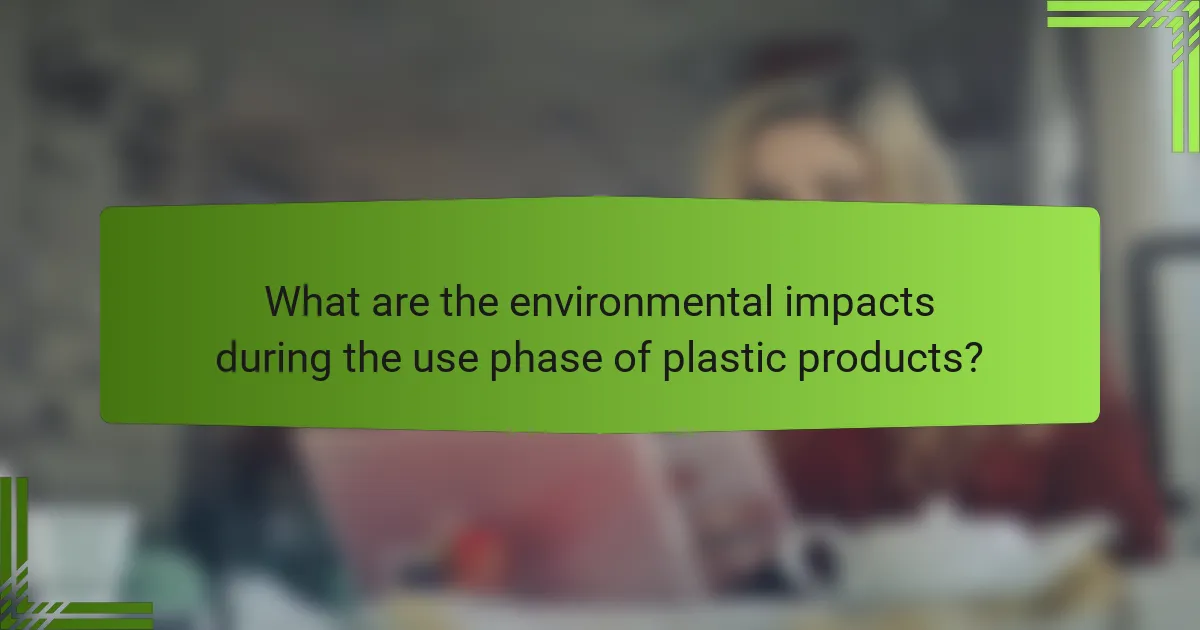
What are the environmental impacts during the use phase of plastic products?
The environmental impacts during the use phase of plastic products include energy consumption, emissions, and waste generation. Plastic products often require energy for their operation, contributing to greenhouse gas emissions. For example, the use of plastic packaging can lead to increased carbon emissions due to the energy needed for refrigeration and transport. Additionally, plastics can release harmful substances during use, affecting air quality. The improper disposal of plastic products during this phase can lead to littering and pollution in ecosystems. Studies indicate that over 300 million tons of plastic are produced annually, with a significant portion used in single-use applications, exacerbating environmental issues.
How do consumer behaviors influence plastic product usage?
Consumer behaviors significantly influence plastic product usage. Increased demand for convenience drives higher plastic consumption. Consumers often prefer single-use plastics due to their practicality. Environmental awareness can lead to reduced plastic usage. Studies show that 73% of consumers are willing to reduce plastic use if alternatives are available. Social media campaigns also shape consumer perceptions about plastics. Positive or negative sentiments can alter purchasing decisions. Brands responding to consumer preferences can reduce plastic packaging.
What are the implications of single-use versus reusable plastic products?
Single-use plastic products contribute significantly to environmental pollution. They are designed for one-time use, leading to increased waste generation. According to the United Nations, approximately 300 million tons of plastic are produced annually, with a substantial portion being single-use. This results in plastic waste that often ends up in oceans and landfills, harming wildlife and ecosystems.
In contrast, reusable plastic products offer a more sustainable alternative. They are intended for multiple uses, which reduces overall plastic consumption. A study published in the journal Environmental Science & Technology found that using a reusable bag can reduce plastic waste by over 500 bags per person per year. This shift can lead to decreased demand for new plastic production, thereby lowering carbon emissions associated with manufacturing.
The implications also extend to resource use. Single-use plastics require significant energy and raw materials for production. Reusable plastics, while initially more resource-intensive, can mitigate this impact over time through repeated use. The lifecycle assessment indicates that the environmental benefits of reusables increase with the number of uses.
Overall, the implications of single-use versus reusable plastic products highlight the need for a shift towards more sustainable consumption practices.
How does product design affect environmental performance during use?
Product design significantly influences environmental performance during use by determining energy efficiency and resource consumption. Well-designed products often require less energy to operate, leading to reduced carbon emissions. For example, energy-efficient appliances consume up to 50% less energy than their traditional counterparts. Additionally, the choice of materials impacts the product’s durability and recyclability. Products designed for longevity minimize waste and reduce the need for replacements. According to a study by the Ellen MacArthur Foundation, improving product design can lead to a reduction of 70% in material consumption. Furthermore, user-friendly designs encourage sustainable practices, such as proper recycling and maintenance. Overall, thoughtful product design is crucial for enhancing environmental performance throughout the product’s use phase.
What are the common disposal methods for plastic products?
Common disposal methods for plastic products include recycling, incineration, landfilling, and composting. Recycling involves processing plastic materials to create new products. Approximately 9% of plastic is recycled globally, according to the World Economic Forum. Incineration burns plastic waste to generate energy, but it can produce harmful emissions. Landfilling is the most prevalent method, with around 79% of plastic waste ending up in landfills. Composting is applicable only to biodegradable plastics, which are designed to break down in specific conditions. Each method has environmental implications that affect sustainability and resource management.
How does recycling impact the lifecycle assessment of plastics?
Recycling significantly improves the lifecycle assessment of plastics by reducing environmental impacts. It lowers energy consumption compared to producing new plastics from raw materials. For instance, recycling PET can save up to 76% of energy used in virgin production. Additionally, recycling decreases greenhouse gas emissions associated with plastic production. According to the EPA, recycling plastics can prevent the release of 1.3 metric tons of carbon dioxide for every ton of plastic recycled. Furthermore, recycling conserves natural resources by reducing the need for virgin materials. This process also minimizes landfill waste, extending the lifespan of existing landfills. Overall, recycling is a critical factor in enhancing the sustainability of plastic products.
What challenges exist in the composting of plastic products?
Composting plastic products faces significant challenges. Most plastics are not biodegradable and do not break down in composting conditions. Common plastics like PET and HDPE can persist for hundreds of years in the environment. Composting facilities often lack the infrastructure to process plastics effectively. Contamination of organic compost with plastic can hinder the quality of the end product. Additionally, some biodegradable plastics require specific conditions to decompose, which are not always met in standard composting operations. The lack of consumer awareness about compostable plastics further complicates effective composting efforts.

How can we improve the lifecycle assessment of plastic products?
Improving the lifecycle assessment of plastic products involves enhancing data accuracy and methodology. Accurate data collection on material extraction, production processes, and transportation is essential. Standardizing assessment methodologies can also ensure consistency across studies. Incorporating end-of-life scenarios, such as recycling and biodegradation, is crucial for a comprehensive view. Engaging stakeholders throughout the supply chain can provide valuable insights and data. Moreover, using advanced modeling techniques can better predict environmental impacts. Research indicates that improved lifecycle assessments can lead to more sustainable plastic product designs. Implementing these strategies can significantly enhance the effectiveness of lifecycle assessments.
What strategies can be implemented to reduce plastic waste?
Implementing strategies to reduce plastic waste involves several key actions. First, promoting recycling programs can significantly decrease plastic waste. According to the Environmental Protection Agency, recycling can divert 75% of waste from landfills. Second, encouraging the use of biodegradable alternatives is crucial. Materials like PLA (polylactic acid) can break down more easily than traditional plastics. Third, implementing stricter regulations on single-use plastics can lead to reduced consumption. For instance, bans on plastic bags in various cities have shown a decrease in plastic litter. Fourth, raising public awareness about plastic pollution can drive behavioral changes. Studies indicate that informed consumers are more likely to choose sustainable products. Lastly, supporting innovations in waste management technologies can improve recycling efficiency. Research from the Ellen MacArthur Foundation highlights advancements in circular economy practices as effective in minimizing plastic waste.
How can consumers contribute to a more sustainable lifecycle for plastics?
Consumers can contribute to a more sustainable lifecycle for plastics by reducing, reusing, and recycling plastic products. Reducing plastic consumption minimizes waste and lowers demand for new plastic production. Reusing items extends their lifespan and decreases the need for single-use plastics. Recycling helps convert used plastics into new products, reducing the environmental impact of plastic waste. According to the Environmental Protection Agency, recycling and composting prevented the release of approximately 186 million metric tons of carbon dioxide equivalent into the air in 2018. By making informed choices, such as selecting products with minimal packaging or made from recycled materials, consumers can further support sustainability efforts. Engaging in local recycling programs also enhances the effectiveness of waste management systems.
What innovations are emerging in plastic product design for sustainability?
Innovations in plastic product design for sustainability include biodegradable plastics, recycled materials, and design for disassembly. Biodegradable plastics, made from renewable resources, decompose more quickly than traditional plastics. Recycled materials reduce the demand for virgin plastic and lower environmental impact. Design for disassembly allows easier recycling and repurposing of products at the end of their life. These innovations aim to minimize waste and enhance the circular economy. Research shows that using recycled content can reduce greenhouse gas emissions by 30-80% compared to new plastic production.
What best practices should industries adopt for better lifecycle assessment?
Industries should adopt a systematic approach to lifecycle assessment (LCA) for improved accuracy and effectiveness. This includes defining clear goals and scope to ensure relevant data is collected. Engaging stakeholders throughout the process enhances transparency and data quality. Utilizing standardized methodologies, such as ISO 14040 and ISO 14044, ensures consistency in assessments. Regularly updating data and methodologies keeps the LCA relevant and accurate. Incorporating sensitivity analysis identifies uncertainties and improves decision-making. Lastly, integrating LCA results into product design and management strategies promotes sustainability. These practices lead to more reliable assessments and informed choices in plastic product lifecycle management.
How can companies measure and report their plastic footprint effectively?
Companies can measure and report their plastic footprint effectively by conducting a comprehensive lifecycle assessment (LCA). This assessment evaluates the environmental impacts of plastic products from production to disposal. It involves quantifying plastic usage across all stages, including sourcing, manufacturing, distribution, use, and end-of-life.
Data collection is essential for accuracy. Companies should gather information on the types and amounts of plastics used. They can also track waste generated and recycling rates. Utilizing standardized frameworks, such as the ISO 14040 series, ensures consistency in reporting.
Transparency is crucial in reporting findings. Companies should disclose methodologies and data sources used in their assessments. Engaging stakeholders, including consumers and suppliers, enhances credibility.
Benchmarking against industry standards provides context for the reported plastic footprint. Companies can use tools like the Plastic Footprint Calculator to simplify the measurement process. Regularly updating assessments reflects improvements and changes in plastic usage.
The Global Commitment by the Ellen MacArthur Foundation encourages companies to set targets for reducing plastic waste. This commitment promotes accountability and progress tracking in sustainability efforts.
What role do stakeholders play in enhancing lifecycle assessments?
Stakeholders play a crucial role in enhancing lifecycle assessments (LCAs). They provide essential data and insights that inform the assessment process. Stakeholders include manufacturers, consumers, regulators, and environmental organizations. Their involvement ensures comprehensive data collection across the entire product lifecycle. For instance, manufacturers can supply precise information on material usage and energy consumption. Consumers can offer feedback on product performance and disposal practices. Regulators can establish guidelines that shape LCA methodologies. Research shows that stakeholder engagement improves LCA accuracy and relevance, leading to better decision-making. A study by the National Academy of Sciences emphasizes that collaborative approaches yield more reliable assessments.
The primary entity of this article is the Lifecycle Assessment (LCA) of plastic products, which systematically analyzes the environmental impacts associated with all stages of a plastic product’s life, including production, use, and end-of-life disposal or recycling. The article outlines the importance of LCA in identifying sustainability improvements, evaluating energy consumption, emissions, and resource depletion, and adhering to regulatory standards. It discusses key stages in the lifecycle, the environmental impacts during use, and various disposal methods, as well as strategies to enhance the sustainability of plastic products through improved design and stakeholder engagement. Overall, the article emphasizes the critical role of LCA in promoting environmental sustainability within the plastic industry.
